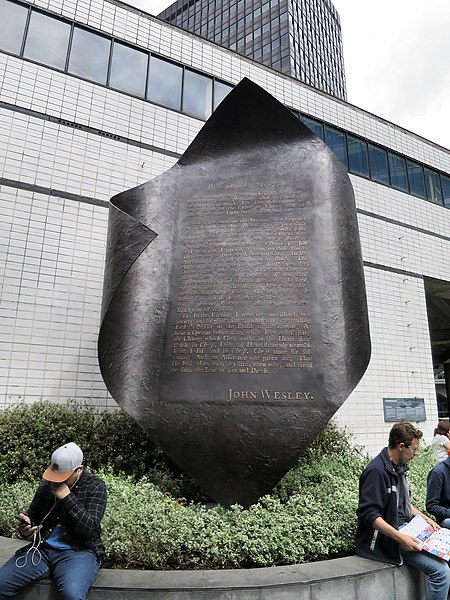File:"Aldersgate Flame". Sculpture marking John Wesley's conversion experience (48329375091).jpg

Original file (3,000 × 4,000 pixels, file size: 2.24 MB, MIME type: image/jpeg)
Captions
Captions
Contents
Summary
Object
| Aldersgate Flame
|
||||||||||||||||||||||||
|---|---|---|---|---|---|---|---|---|---|---|---|---|---|---|---|---|---|---|---|---|---|---|---|---|
| Title |
Aldersgate Flame label QS:Len,"Aldersgate Flame" |
|||||||||||||||||||||||
| Object type |
sculpture |
|||||||||||||||||||||||
| Genre |
public art |
|||||||||||||||||||||||
| Description |
The bronze sculpture was erected in 1981. It is sited at the approximate location of John Wesley's conversion experience on 24 May 1738. The text is an excerpt from Wesley's journal. The key final paragraph is also set out on <a href="https://en.wikipedia.org/wiki/John_Wesley#Wesley's_" rel="noreferrer nofollow">a Wikipedia page</a> about the "Aldersgate Flame" and John Wesley. I've slightly edited my original photo to increase contrast and sharpness and make it easier to read. I also recommend viewing the <a href="https://www.flickr.com/photos/alanstanton/48329375091/sizes/o/"> largest (original) size</a> photo. (As was customary in 1738, the tall/elongated letter 's' is written like a sloping 'f' without a bar.) The sculpture is on a public walkway above the street outside the entrance to the Museum of London. This is located at the junction of Aldersgate Street and the road now known as "London Wall". This refers to the few remaining parts of the original medieval city wall, which enclosed the area now known as the City of London. "The City" for short. The Museum is a short walk from Barbican tube station (London Underground). It's part of The Barbican Estate. This area was heavily bombed during World War II. It's in the Cripplegate ward of the City of London which was virtually demolished. By 1951 the resident population of the City stood at 5,324 of whom 48 lived in Cripplegate. § Wikipedia link to <a href="https://en.wikipedia.org/wiki/Barbican_Estate" rel="noreferrer nofollow">the Barbican Estate</a> - accessed 20 July 2019.) [...]The estate was built between 1965 and 1976, on a 35-acre (14 ha) site that had been bombed in World War II. [...] The flats reflect the widespread use in Britain in the 1960s and 1970s of concrete as the visible face of the building." |
|||||||||||||||||||||||
| Date |
1981 |
|||||||||||||||||||||||
| Medium |
bronze |
|||||||||||||||||||||||
| Collection |
institution QS:P195,Q917820
|
|||||||||||||||||||||||
| Object location |
|
|||||||||||||||||||||||
| Object history | ||||||||||||||||||||||||
Photograph
| Date | |
| Source | "Aldersgate Flame". Sculpture marking John Wesley's conversion experience |
| Author | Alan Stanton |
| Camera location | 51° 31′ 05.02″ N, 0° 05′ 48″ W | View this and other nearby images on: OpenStreetMap |
|---|
Licensing
| This file is made available under the Creative Commons CC0 1.0 Universal Public Domain Dedication. | |
| The person who associated a work with this deed has dedicated the work to the public domain by waiving all of their rights to the work worldwide under copyright law, including all related and neighboring rights, to the extent allowed by law. You can copy, modify, distribute and perform the work, even for commercial purposes, all without asking permission.
http://creativecommons.org/publicdomain/zero/1.0/deed.enCC0Creative Commons Zero, Public Domain Dedicationfalsefalse |
| This image was originally posted to Flickr by Alan Stanton at https://flickr.com/photos/53921762@N00/48329375091 (archive). It was reviewed on 29 November 2019 by FlickreviewR 2 and was confirmed to be licensed under the terms of the cc-zero. |
29 November 2019
File history
Click on a date/time to view the file as it appeared at that time.
| Date/Time | Thumbnail | Dimensions | User | Comment | |
|---|---|---|---|---|---|
| current | 18:36, 29 November 2019 |  | 3,000 × 4,000 (2.24 MB) | Ham II (talk | contribs) | Transferred from Flickr via #flickr2commons |
You cannot overwrite this file.
File usage on Commons
The following page uses this file:
File usage on other wikis
The following other wikis use this file:
- Usage on de.wikipedia.org
Metadata
This file contains additional information such as Exif metadata which may have been added by the digital camera, scanner, or software program used to create or digitize it. If the file has been modified from its original state, some details such as the timestamp may not fully reflect those of the original file. The timestamp is only as accurate as the clock in the camera, and it may be completely wrong.
| Camera manufacturer | Canon |
|---|---|
| Camera model | Canon PowerShot S120 |
| Exposure time | 1/2,000 sec (0.0005) |
| F-number | f/1.8 |
| ISO speed rating | 160 |
| Date and time of data generation | 14:14, 18 July 2019 |
| Lens focal length | 5.2 mm |
| Orientation | Normal |
| Horizontal resolution | 180 dpi |
| Vertical resolution | 180 dpi |
| Software used | Microsoft Windows Photo Viewer 6.1.7600.16385 |
| File change date and time | 13:07, 20 July 2019 |
| Y and C positioning | Co-sited |
| Exif version | 2.3 |
| Date and time of digitizing | 14:14, 18 July 2019 |
| Meaning of each component |
|
| Image compression mode | 3 |
| APEX shutter speed | 10.96875 |
| APEX aperture | 1.6875 |
| APEX exposure bias | 0 |
| Maximum land aperture | 1.6875 APEX (f/1.79) |
| Metering mode | Pattern |
| Flash | Flash did not fire, compulsory flash suppression |
| Supported Flashpix version | 1 |
| Color space | sRGB |
| Focal plane X resolution | 13,745.704467354 |
| Focal plane Y resolution | 13,698.630136986 |
| Focal plane resolution unit | inches |
| Sensing method | One-chip color area sensor |
| File source | Digital still camera |
| Custom image processing | Normal process |
| Exposure mode | Auto exposure |
| White balance | Auto white balance |
| Digital zoom ratio | 1 |
| Scene capture type | Standard |

